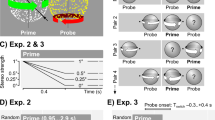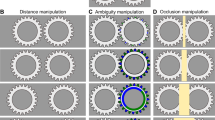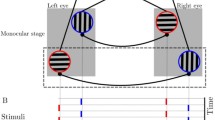Abstract.
The phenomenon of stroboscopic alternative motion exhibits five different percepts that are seen with an increase in the frequency of presentation: (a) succession, (b) fluttering motion, (c) reversible clockwise and counter-clockwise turning motion, (d) oppositional motion and (e) simultaneity. From a synergetic point of view the increase in frequency is a control parameter and the different percepts are order parameters with phase transitions in between. The neural network model of Carmesin and Arndt is applied to receive predictions about hysteresis and phase transitions between these order parameters. Empirical data show the different motion percepts (b), (c) and (e) have lognormal distributions. Following the theoretical model, it is argued that there are three different phases, (a), (c) and (e), with two continuous phase transitions, (b) and (d), between them. The experimental data substantially match the theoretical ssumptions.
Similar content being viewed by others
Author information
Authors and Affiliations
Additional information
Received: 29 December 1995 / Accepted in revised form: 3 June 1996
Rights and permissions
About this article
Cite this article
Kruse, P., Carmesin, HO., Pahlke, L. et al. Continuous phase transitions in the perception of multistable visual patterns . Biol Cybern 75, 321–330 (1996). https://doi.org/10.1007/s004220050298
Issue Date:
DOI: https://doi.org/10.1007/s004220050298




